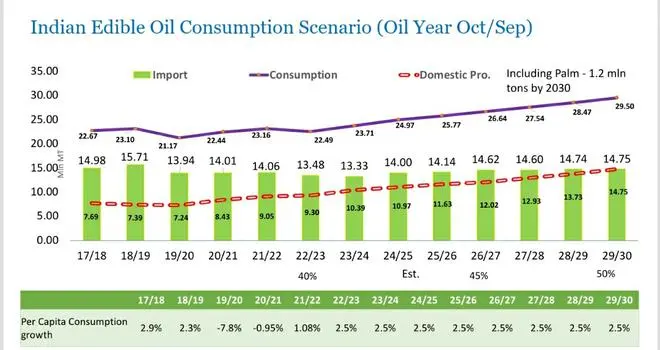

From a flattish 7.24 million tonnes in 2019-20, the domestic production increased to 8.43 mt in 2020-21 and 9.05 mt in 2021-22. | Photo Credit: Bloomberg
Smiles are back on the faces of Indian vegetable oil producers as edible consumption is back to pre-Covid levels. Edible oil per capita consumption declined 7.8 per cent in the 2019-20 season (November-October) and volatile prices in the subsequent years affected the offtake further. And now, comes the good news for edible oil producers.
“It (per capita consumption) saw a decline of 0.95 per cent in 2020-21 and registered a modest growth rate of 1.08 per cent last year. We are expecting the present financial year to see a growth of 2.5 per cent,” Sudhakar Desai, President of Indian Vegetable Oil Producers’ Association (IVPA), told businessline.

Source: Estimates prepared by the Indian Vegetable Oil Producers’ Association (IVPA)
Interestingly, the country is also witnessing a steady growth in domestic production, strongly driven by the growth in mustard output
With weak off-take during the Covid pandemic due to the supply chain disruptions, high prices and lower purchasing power, the domestic production of edible oil increased at the same time, outstrippling consumption..
From a flattish 7.24 million tonnes (mt) in 2019-20, the domestic production increased to 8.43 mt in 2020-21 and 9.05 mt in 2021-22. “We are expecting this to go up to 9.3 mt in 2022-23,” he said.
Citing the examples of Covid-19 and the Ukraine-Russia war, he said disruptions in the global supply chain could make the country vulnerable. “You need to increase self-reliance by increasing domestic production. We are now dependent on imports, constituting nearly 60 per cent of our annual requirements of 23-24 mt,” Desai said.
Achieving 100 per cent self-sufficiency was not possible, but the country could attempt to change the domestic component to 45-60 per cent. “It is doable in the next 7-8 years. We need to focus on a bouquet of oil crops to get there,” he said.
“Increasing our domestic cultivation is the only solution. It will take time, but it is doable,” he said.
He said the bulk of growth in the domestic production is from mustard. Seeing a huge demand, farmers have shown interest in growing more mustard.
He said the permission to cultivate genetically-modified mustard granted recently would help further improving the situation. India should focus on mustard and rice bran oil because they are imported, he said.
Palm oil, however, holds the key, accounting for over half of the last year’s imports of 13.78 mt.
With India kicking off the oil palm mission and Telangana targeting to grow oil palm in 20 lakh acres, he said the domestic production would help reduce the imports.
Desai, however, wanted the country to focus on increasing productivity, which was low when compared to global benchmarks.
“With the same acreage, the global market is able to produce three to four times more oil seeds. So productivity is a low hanging fruit to achieve,” he said.
Published on November 21, 2022

Comments
Comments have to be in English, and in full sentences. They cannot be abusive or personal. Please abide by our community guidelines for posting your comments.
We have migrated to a new commenting platform. If you are already a registered user of TheHindu Businessline and logged in, you may continue to engage with our articles. If you do not have an account please register and login to post comments. Users can access their older comments by logging into their accounts on Vuukle.